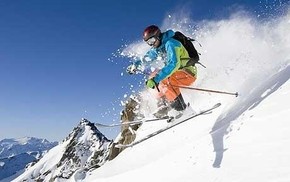Skiing can be an exciting and fulfilling sport, whether you compete or take to the slopes over long weekends. In fact, alpine skiing accounts for about one third of the athletes on the snow slopes. But, like any other sport, skiing involves a high risk of injury.
Many athletes injure these body parts while skiing. Learning more about how skiing injuries commonly occur can help you avoid injuries the next time you visit a ski run.
Hand
Skiers use their hands and wrists nearly constantly while performing. Often when a skier slips or falls with a ski pole in their hand, they sustain what’s known as a “skier’s thumb” injury. When an athlete falls with the pole in their hand, the pole acts as a fulcrum, straining the thumb ligament or even tearing it.
How to Avoid Hand Injuries: You can prevent skier’s thumb by skiing without your pole wrist straps on. Your pole may slide down the hill a bit after a tumble, but at least you’ll still be able to pick it up. You may also be able to purchase ski equipment that clips the poles directly to your gloves, changing the angle in case of a fall.
Knee
Knee injuries are the most common skiing injuries. They have been somewhat reduced by the introduction of carving skis, but they are still your biggest risk while skiing. About 30 to 40% of skiing knee injuries involve the ACL, or Anterior Cruciate Ligament.
Serious injuries can reduce mobility and prevent further skiing and other everyday activity. Watch for these signs which may indicate a knee injury:
•obvious change of knee shape
•inability to bear weight
•excessive swelling
•excessive tenderness
•inability to straighten the knee
How to Avoid Knee Injuries: If you are skiing with older skis, switch to carving skis. Your position can also drastically affect your risk of injury. Experts recommend keeping your knees bent, weight distributed to the balls of your feet, and elbows bent.
Back and Neck
As with any other high-impact sport, there is the risk of back and neck injuries. Skiers are at particular risk for back and neck strain due to the amount of core strength required by the sport.
You may experience any of these common injuries:
•shoulder dislocation
•back muscle pain
•neck headaches
•pinched nerves
•sciatica
Back injuries are particularly dangerous if they damage your spinal cord. Spinal cord injuries may result in loss of feeling and motor control below the site of injury or even paralysis (source: Bronson Jones & Co., a personal injury firm in Vancouver).
How to Avoid Back Injuries: The best way to prevent back and neck injuries during the ski season is to practice common sense. Follow these guidelines to protect your back and neck safe:
•Begin exercising at least six weeks before you hit the slopes. If you haven’t been on the slopes in a long time or are particularly out of shape, consider beginning your training several months in advance.
•Avoid carrying heavy equipment up the slopes if you have a history of back or neck pain, strain, or injuries.
•Ski on slopes that fit your ability level.
•Always take a practice run before you begin a more challenging course.
Take any pre-existing conditions into account when you are preparing to ski. If, for example, you’ve experienced joint pain in your elbow, do stretches and wear a brace when you hit the slopes.
While you cannot prevent all injuries, following these tips can help keep you safer while you improve your shredding skills.




